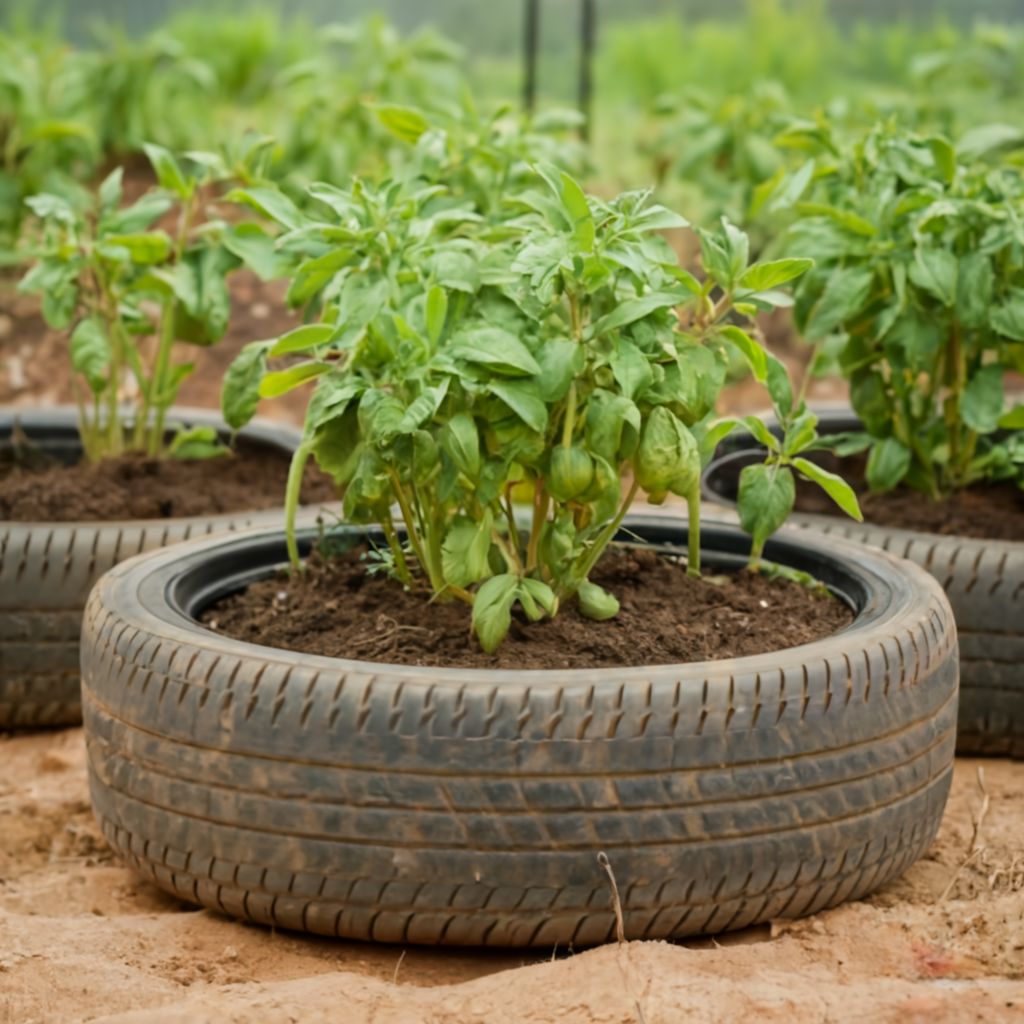
Ever dreamt of spudtacular success in the vegetable patch, but limited on space or traditional gardening know-how? Look no further than the humble tire! This ingenious method of cultivating potatoes, aptly named “tire gardening,” offers a unique, space-saving, and surprisingly productive way to grow your own delicious spuds.
From Rubber Rings to Root Rooms: Why Tires?
Traditional in-ground potato farming requires ample space and specific soil conditions. Tire gardening, however, transcends these limitations. Here’s why used tires are surprisingly perfect for cultivating potatoes:
- Space Efficiency: Stacking tires vertically allows you to grow upwards, maximizing yield in a limited footprint. This is ideal for balconies, patios, or even small backyards.
- Improved Drainage: Tires, with their naturally porous nature, prevent waterlogging, a common enemy of potato plants. This is especially beneficial in areas with heavy rainfall.
- Warming Potential: Dark-colored tires absorb heat from the sun, creating a warmer environment for the potatoes, particularly during cooler nights. This can accelerate growth, especially in regions with shorter growing seasons.
- Upcycling Potential: Instead of sending old tires to landfills, tire gardening gives them a new lease on life, contributing to a more sustainable practice.
Building Your Spud Tower: A Step-by-Step Guide
Now that you’re convinced of the potential of tire gardening, let’s get your hands dirty (but hopefully not too dirty!) and build your very own spud tower:
Materials:
- Used tires (washed and free of debris) – Choose at least two to three tires with similar diameters, ensuring they can be stacked securely.
- Well-draining potting mix – Opt for a mixture rich in organic matter and nutrients.
- Seed potatoes – Certified disease-free seed potatoes are recommended, and choose varieties suitable for your climate.
- Shovel
- Gardening gloves (optional)
Steps:
- Prepare the Tires: Poke several drainage holes in the bottom of each tire using a drill or sharp tool. Wash the tires thoroughly with soapy water to remove any dirt or residue.
- Create the Base: Place one tire in a sunny location, receiving at least 6-8 hours of sunlight daily. Fill the bottom third of the tire with well-draining potting mix.
- Planting the Seed Potatoes: Cut your seed potatoes into pieces, each containing at least one “eye” (the small indentations where new shoots emerge). Lay the potato pieces cut-side down on the potting mix, leaving about 4-6 inches of space between each piece.
- Stacking and Adding Soil: Carefully place another tire on top of the first one, ensuring proper alignment. Fill this second tire halfway with potting mix, gently covering the planted potatoes.
- Nurturing Your Spud Tower: Water your newly planted potatoes thoroughly and keep the soil consistently moist but not waterlogged. As the potato plants sprout and grow, add more potting mix to the top tire, gradually burying the lower portion of the stems.
- Adding More Tires (Optional): As your plants continue to grow, you can add another tire and repeat step 5, creating a taller “spud tower.” This allows for even more yield potential.
- Signs of Maturity: Once the potato plants reach a mature height and the foliage begins to yellow and die back, it’s harvest time!
Tips:
- To deter pests like slugs and snails, sprinkle a layer of diatomaceous earth around the base of the tire tower.
- Regularly check for signs of disease or insect infestation.
- Harvest potatoes as needed throughout the growing season, or wait until the plants die back completely for a larger final harvest.
Harvesting the Rewards: Enjoying Your Homegrown Bounty
The moment of truth has arrived! It’s time to unearth those delicious spuds you’ve nurtured with care. Here’s how to harvest your potato bounty:
- Carefully Dismantle the Tower: Start by removing the top tire(s) and gently brush away any loose soil.
- Unearthing the Spuds: Feel around the base of the plants and gently remove the potatoes by hand. Be careful not to damage the delicate tubers.
- Repeat and Enjoy: Continue dismantling the remaining tires, harvesting potatoes from each layer.
Once harvested, store your potatoes in a cool, dark, and well-ventilated place to enjoy them for weeks to come.
Beyond the Basics: Taking Your Tire Garden to the Next Level (continued)
- Companion Planting: Consider companion planting with herbs like marigolds or nasturtiums, which can deter certain pests and attract beneficial insects.
- Fertilization: Implement a light fertilization schedule using organic fertilizers or compost tea to provide additional nutrients for optimal growth.
- Winter Protection: In colder climates, protect your spud tower during harsh winters by covering it with straw or burlap sacks.
- Creative Aesthetics: Don’t be afraid to get creative! Paint your tires in vibrant colors, add decorative elements, or even incorporate your spud tower into existing garden structures for a touch of personality.
